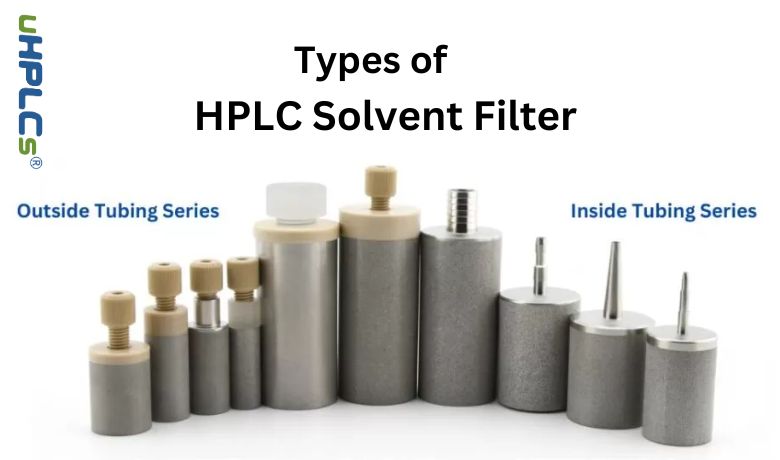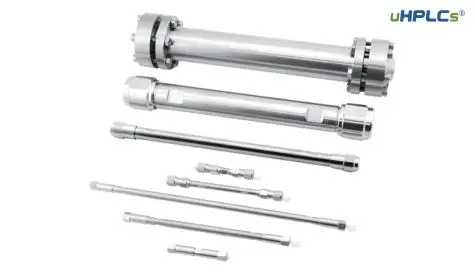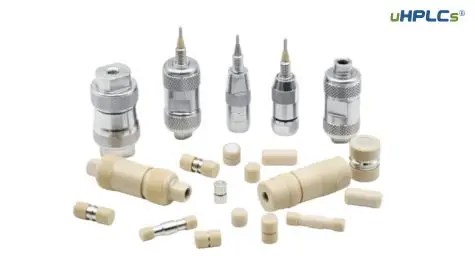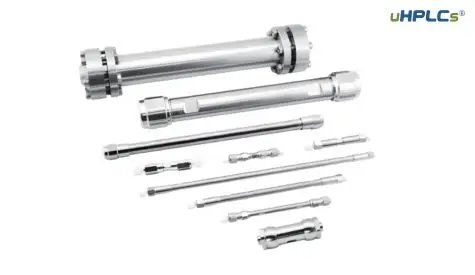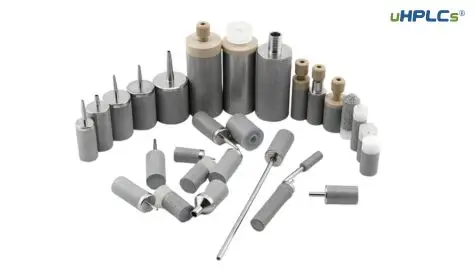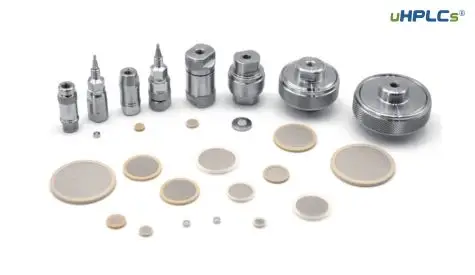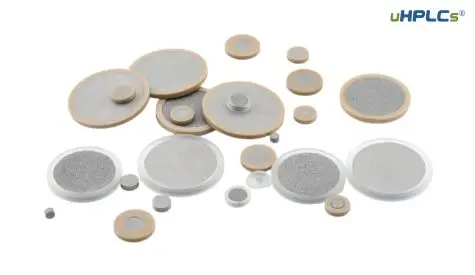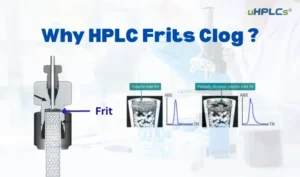1. What is HPLC Solvents
HPLC Solvents, also known as High-Performance Liquid Chromatography Solvents, are a group of pure organic liquids used in High-Performance Liquid Chromatography (HPLC). HPLC is an analytical technique used to separate, identify, and quantify various compounds in a mixture. It is widely used in laboratories and industries for a wide range of applications, including pharmaceuticals, environmental analysis, food and beverage testing, and more.
In HPLC, a liquid mobile phase (solvent) is used to carry the sample through a chromatographic column, where the separation of compounds occurs based on their interactions with the stationary phase. The choice of solvent is crucial in HPLC, as it directly influences the separation efficiency, sensitivity, and resolution of the analysis.
HPLC solvents are typically high-purity liquids with low levels of impurities and additives that could interfere with the analysis. Common HPLC solvents include water, acetonitrile, methanol, ethanol, and various other organic solvents. The selection of solvents depends on the nature of the analytes being separated and the specific chromatographic method being used.
To ensure accurate and reproducible results in HPLC, it is essential to use high-quality solvents and properly maintain the HPLC system to prevent any contamination or changes in the solvent composition. Proper handling and storage of HPLC solvents are also necessary to maintain their purity and avoid any degradation over time.
2. Components For HPLC Solvents
The components around HPLC Solvents include:
A: Solvents
These are the high-purity liquid substances used as the mobile phase in High-Performance Liquid Chromatography (HPLC). Solvents are essential for carrying the sample through the chromatographic column for separation and analysis.
B: HPLC Solvent Bottles
These are special containers designed to store and dispense the HPLC solvents. They are typically made of materials that are compatible with the solvents used and may have features like low gas permeability to prevent evaporation or contamination.
C: HPLC Solvent Filter
This is a crucial component used to remove particulates and impurities from the HPLC solvents before they enter the chromatographic system. The filter ensures that the solvents are of high purity, preventing any interference with the analysis and protecting the sensitive HPLC instrumentation.
D: HPLC Solvent Tubing
This refers to the tubing that connects various parts of the HPLC system, including the solvent bottles, pump, injector, column, and detector. It is important to use high-quality tubing that is chemically compatible with the solvents and does not contribute to contamination or degradation of the solvents during the analysis.
These components work together to ensure the accuracy, reproducibility, and efficiency of the HPLC analysis by maintaining the purity of the solvents and delivering them smoothly through the chromatographic system. Proper selection, handling, and maintenance of these components are critical to achieving reliable and precise results in HPLC.

3. HPLC Solvents
3.1 Why use HPLC Solvents ?
HPLC Solvents are used for several important reasons in High-Performance Liquid Chromatography (HPLC):
-
Sample Separation: HPLC Solvents serve as the mobile phase that carries the sample through the chromatographic column. The chromatographic column contains a stationary phase with specific interactions with the solutes in the sample. As the mobile phase (solvent) flows through the column, it interacts with the sample, separating its components based on their chemical properties. This separation allows for the identification and quantification of individual compounds in complex mixtures.
-
Analyte Detection: HPLC Solvents are crucial for the detection of analytes (compounds of interest) in the sample. The separated compounds are eluted from the column and pass through a detector that measures their concentration. The solvent plays a role in ensuring accurate and sensitive detection, as the choice of solvent can influence the detector response.
-
Purity and Reproducibility: HPLC Solvents are selected for their high purity and low impurity levels. Using pure solvents ensures that the only components present in the chromatographic system are the ones introduced deliberately. This helps maintain reproducibility and reliability in HPLC analyses.
-
Sensitivity and Accuracy: The selection of appropriate HPLC Solvents can significantly impact the sensitivity and accuracy of the analysis. Certain solvents may provide better separations or enhance the detection response of specific analytes, leading to improved sensitivity and more accurate quantification.
-
Compatibility with HPLC System: HPLC Solvents are chosen based on their compatibility with the HPLC instrumentation and the stationary phase in the chromatographic column. Using incompatible solvents could lead to system damage, decreased column performance, or other technical issues.
-
Application Flexibility: Different types of HPLC Solvents, such as water, acetonitrile, methanol, and others, offer different solvent strengths and selectivities. This allows researchers to optimize the HPLC method for a wide range of applications, making HPLC a versatile analytical technique.
In summary, HPLC Solvents play a critical role in achieving accurate, sensitive, and reliable results in High-Performance Liquid Chromatography. They enable the separation, detection, and quantification of compounds in complex mixtures and are essential for the success of various scientific and industrial applications, including pharmaceuticals, environmental analysis, food and beverage testing, and more.

3.2 Types of HPLC Solvent ?
There are several types of HPLC solvents commonly used in High-Performance Liquid Chromatography. These solvents differ in their properties and strengths, allowing researchers to choose the most suitable solvent system for specific chromatographic separations. Here we make a HPLC Solvents List common types of HPLC solvents include:
Water: Water is the most widely used HPLC solvent and is often used as a starting mobile phase for many separations. It is a polar solvent and is particularly effective for the analysis of hydrophilic compounds.
Acetonitrile (ACN): Acetonitrile is a popular organic solvent in HPLC due to its relatively high polarity and low UV absorbance. It is widely used for a broad range of analytes and is often preferred for reverse-phase chromatography.
Methanol (MeOH): Methanol is another commonly used organic solvent in HPLC. It has higher UV absorbance compared to acetonitrile, making it suitable for ultraviolet detection. Methanol is often used for separating non-polar and moderately polar compounds.
Ethanol (EtOH): Ethanol is occasionally used in HPLC, especially for certain applications where it may provide specific selectivity or advantages.
Isopropanol (IPA): Isopropanol is a less frequently used HPLC solvent, but it can be employed in specific cases where it offers benefits over other solvents.
Tetrahydrofuran (THF): Tetrahydrofuran is sometimes used in specialized applications, particularly for the separation of non-polar analytes.
Dimethyl Sulfoxide (DMSO): DMSO is used in certain instances, especially for polar and large-molecule separations.
Hexane: Hexane is a non-polar solvent used in HPLC for the separation of non-polar analytes or as a modifier in mobile phase preparation.
Chloroform: Chloroform is used occasionally in HPLC, although its use is limited due to its toxicity and hazardous nature.
It is essential to select the appropriate HPLC solvent or solvent mixtures based on the nature of the analytes being separated, the stationary phase of the chromatographic column, and the specific chromatographic method being employed. The choice of solvent significantly influences the separation efficiency, sensitivity, and selectivity of the HPLC analysis.
3.3 Classification by Function and Use of HPLC Solvent
HPLC solvents can be classified into different categories based on their intended use and application. Here are some common classifications of HPLC solvents:
Common HPLC Solvents: These are the general-purpose solvents that are widely used in various HPLC applications. They include solvents like water, acetonitrile, methanol, ethanol, isopropanol, and others. These solvents are versatile and can be used in a wide range of chromatographic separations.
HPLC Grade Solvents: These are solvents that meet high-purity standards required for HPLC applications. HPLC grade solvents are carefully purified to ensure low levels of impurities that could interfere with the analysis. They are used to ensure the accuracy and reliability of HPLC results.
HPLC Flushing Solvent: This refers to a solvent used to flush and clean the HPLC system between runs to prevent carryover of analytes from one sample to the next. Typically, a strong solvent like methanol or acetonitrile is used for this purpose.
Normal Phase HPLC Solvents: In normal phase HPLC, the stationary phase is polar, and the mobile phase is non-polar. Therefore, solvents with higher polarity like water or mixtures of water with polar organic solvents (e.g., methanol) are commonly used in normal phase HPLC.
Reverse Phase HPLC Solvents: In reverse phase HPLC, the stationary phase is non-polar, and the mobile phase is polar. Organic solvents with low polarity like acetonitrile, methanol, or mixtures of these solvents with water are frequently used in reverse phase HPLC.
The choice of HPLC solvent and its classification depends on the specific chromatographic method, the nature of the analytes to be separated, and the type of column used in the HPLC system. Proper selection and handling of HPLC solvents are essential to achieve accurate and reproducible results in liquid chromatographic analyses.
3.4 Which solvent is best for hplc ?
Do you know hplc solvent selection ?
The best solvent for HPLC depends on the specific application, the nature of the analytes being separated, and the type of chromatographic column used. There is no one-size-fits-all answer to this question as different solvents offer different selectivities and separation efficiencies. The selection of an HPLC solvent or a solvent mixture should be based on the following considerations:
Analyte Solubility: The solvent should be able to dissolve the analytes of interest effectively. If the analytes are hydrophilic (water-loving), a polar solvent like water or a water-acetonitrile mixture may be suitable. For hydrophobic (water-repelling) analytes, non-polar solvents like acetonitrile or methanol might be better choices.
Stationary Phase: Consider the polarity of the stationary phase in the chromatographic column. For reverse phase HPLC (non-polar stationary phase), polar solvents like acetonitrile and water mixtures are commonly used. For normal phase HPLC (polar stationary phase), non-polar solvents like hexane or heptane may be preferred.
Detector Compatibility: The solvent should be compatible with the detection method used in the HPLC system. For example, if you are using UV detection, the solvent should have low UV absorbance in the wavelength of interest to avoid interference with the detection.
Purity: High-purity HPLC grade solvents are essential to prevent contamination and interference with the analysis. Always use solvents with the appropriate level of purity for the intended application.
Reproducibility: Ensure that the selected solvent provides consistent and reproducible results over time and between different runs.
Safety and Environmental Considerations: Consider the safety and environmental impact of the solvent being used. Some solvents might be hazardous or have disposal restrictions.
Method Validation: If the method has already been validated using a specific solvent, it is generally best to stick to that solvent to maintain consistency.
Ultimately, HPLC solvent selection should be based on a combination of these factors, and it is often a result of experimentation and optimization. Proper solvent selection is crucial to achieve accurate and reliable results in HPLC analyses.
4. HPLC Solvent Bottles
4.1 Types of HPLC Solvent Bottle
HPLC solvent bottles come in various designs and materials to meet the specific needs of laboratories and chromatographic systems. Some common types of HPLC solvent bottles include:
Glass Bottles: Glass bottles are a traditional choice for HPLC solvent storage. They are chemically inert and compatible with a wide range of solvents. Amber glass bottles are often used to protect light-sensitive solvents from degradation.
Plastic Bottles: Plastic bottles are a lightweight and cost-effective alternative to glass bottles. They are available in various materials such as high-density polyethylene (HDPE) or polypropylene (PP). Plastic bottles are suitable for many common HPLC solvents, but their compatibility may vary depending on the solvent type and concentration.
Safety-Coated Bottles: Some solvent bottles are coated with a protective layer to contain any potential leaks in case of bottle breakage. This safety feature is particularly important for hazardous solvents.
Screw Cap Bottles: These bottles have screw-on caps with airtight seals to prevent solvent evaporation and contamination. They are easy to open and close, making solvent changes or refilling convenient.
Cap with Septum: Bottles equipped with caps featuring a septum are useful for direct injection of samples into the HPLC system. The septum allows for the use of syringes to draw samples from the bottle without opening it, reducing the risk of contamination.
Pressure-Sensitive Bottles: These bottles are designed to withstand increased pressure, which can be necessary for certain HPLC applications or to accommodate certain HPLC systems.
Graduated Bottles: Some HPLC solvent bottles come with graduated markings on the sides, allowing for precise measurement of the solvent volume added or used during an analysis.
Reservoir Bottles: Reservoir bottles are larger containers used to supply HPLC solvents to the system automatically. They are commonly used in high-throughput analyses.
The choice of HPLC solvent bottle depends on factors such as solvent compatibility, safety considerations, sample injection method, and the specific requirements of the HPLC system being used. It is essential to use high-quality bottles to ensure the integrity and purity of the solvents and to maintain the reliability of HPLC analyses.
4.2 Size of HPLC Solvent Bottles
HPLC solvent bottles come in various sizes to accommodate different laboratory needs and HPLC system setups. The size of HPLC solvent bottles is typically specified in volume units, such as milliliters (mL) or liters (L). Common sizes of HPLC solvent bottles include:
100 mL: This is a common small size used for storing smaller amounts of solvents or for specific applications where a smaller volume is required.
250 mL: A larger size that is still relatively compact and is often used for frequently used solvents in HPLC analysis.
500 mL: A medium-sized bottle suitable for HPLC solvents that are used regularly but not in large quantities.
1 L: This size is commonly used for storing larger amounts of solvents or for use as a reservoir bottle to supply solvents to the HPLC system.
2 L: Larger bottles used for bulk storage of solvents or as reservoirs for high-throughput HPLC systems.
4 L (1 gallon): These bottles are used for bulk storage or in high-throughput laboratories with significant solvent consumption.
The choice of HPLC solvent bottle size depends on the volume of solvents required for the specific HPLC analysis and the frequency of use. Smaller bottles are practical for less commonly used solvents or when only small amounts are needed for specific experiments. On the other hand, larger bottles are suitable for frequently used solvents or when preparing large quantities of mobile phase solutions.
It’s important to consider factors like solvent evaporation, potential contamination, and the shelf life of the solvent when selecting the appropriate size of HPLC solvent bottles. Proper storage and handling of solvents are essential to ensure the integrity and reliability of HPLC analyses.

4.3 Why You Should Use HPLC Solvent Bottle Caps ?
HPLC solvent bottle caps are an essential component of the solvent storage system in High-Performance Liquid Chromatography (HPLC). These caps serve several important purposes:
Preventing Evaporation: HPLC solvent bottle caps have airtight seals that help prevent solvent evaporation. Solvent evaporation can lead to changes in solvent concentration and affect the performance of the chromatographic analysis. A secure cap minimizes solvent loss and ensures the stability of the solvent composition over time.
Contamination Prevention: The cap forms a barrier that protects the solvent from contamination. Dust, airborne particles, and microorganisms could potentially enter the bottle and contaminate the solvent, which could interfere with the analysis or cause instrument issues. A well-sealed cap helps maintain the purity of the solvent and prevents any external substances from entering.
Safety: Some HPLC solvents can be hazardous, and their exposure should be minimized. The cap provides an additional layer of safety, especially for toxic or volatile solvents. It helps reduce the risk of accidental spills or exposure during handling and storage.
Sample Injection: Some HPLC solvent bottle caps are designed with a septum, a rubber-like material that allows for direct injection of samples into the HPLC system without the need to open the bottle. This feature facilitates sample preparation and minimizes the risk of contamination during the injection process.
Easy Handling: The caps are typically designed for easy opening and closing, making it convenient to refill or change solvents in the HPLC system.
Pressure Resistance: For certain HPLC applications, especially in specialized systems, the solvent bottles may experience pressure changes. The caps are designed to withstand these pressure fluctuations to maintain the integrity of the solvent system.
Proper use and maintenance of HPLC solvent bottle caps are essential to ensure the integrity and reliability of HPLC analyses. It is important to check the condition of the caps regularly, replace damaged or worn-out caps, and properly tighten them to avoid any leaks or issues during solvent storage and usage.
In High-Performance Liquid Chromatography (HPLC), an HPLC Solvent Filter is an important component used for solvent filtration before entering the chromatographic system. It is one part of the HPLC solvent filtration process.
The HPLC Solvent Filter is a device or assembly that removes particulates, debris, and impurities from the HPLC solvents before they are introduced into the chromatographic system. These filters are designed to ensure that the solvents used in HPLC are of high purity, free from contaminants, and do not interfere with the analysis.
5.1 Types of HPLC Solvent Filter ?
There are several types of HPLC solvent filters available, each designed to meet specific filtration needs and solvent compatibility requirements. The types of HPLC solvent filters include:
Syringe Filters: These are small, disposable filters that are attached to the end of a syringe. They are used for manual filtration of small volumes of solvents before injection into the HPLC system. Syringe filters are convenient and come in various materials and pore sizes to accommodate different solvent types.
Inline Filters: Inline filters are larger filters that are connected directly into the HPLC system’s solvent line. They are positioned between the solvent reservoir and the pump to filter the solvent before it enters the chromatographic system. Inline filters come in various configurations, such as stainless steel or PTFE, and with different pore sizes to suit specific applications.
In-line Guard Cartridges: Guard cartridges are designed to protect the HPLC column from particulates and impurities that may come from the solvents. They are placed before the column in the chromatographic system and function as an additional filtration step for the mobile phase.
Column Filters: Some HPLC columns come with built-in filters to act as a pre-column filtration step. These filters help protect the column from particulate contamination and improve column longevity.
Bottle Top Filters: These are designed to filter larger volumes of solvents directly from the solvent bottle. They typically fit onto standard solvent bottles and allow for convenient, high-volume filtration.
Capsule Filters: Capsule filters are small, enclosed filters used for various laboratory applications, including HPLC solvent filtration. They can be used for small-scale solvent filtration or as a final step before sample injection.
Inline Membrane Filters: These filters are designed to fit directly into the HPLC solvent line and provide reliable and consistent filtration.
The choice of HPLC solvent filter depends on factors such as the volume of solvent to be filtered, the specific filtration requirements, the compatibility with the solvent type, and the overall setup of the HPLC system. Using the appropriate filter is crucial to maintain the purity of the solvent and prevent interference with the HPLC analysis. Regular maintenance and replacement of filters are necessary to ensure optimal performance and reliable results in HPLC analyses.
5.2 Why use Sintered Metal HPLC Solvent Filter ?
Sintered stainless steel is commonly used in HPLC solvent filters due to its unique properties and advantages that make it well-suited for this application. Here are some reasons why sintered stainless steel is preferred for HPLC solvent filters:
High Chemical Compatibility: Sintered stainless steel is highly resistant to corrosion and chemical attack. It can withstand exposure to a wide range of HPLC solvents, including acidic, basic, and organic solvents, without degrading or leaching any impurities into the solvents. This chemical stability ensures that the filtered solvents remain pure and free from contamination.
Robust and Durable: Sintered stainless steel filters are strong and durable, making them ideal for repeated use and prolonged exposure to various solvents. They can withstand the pressure and flow rates commonly encountered in HPLC systems without breaking or collapsing.
Uniform Pore Structure: Sintered stainless steel filters are manufactured using a sintering process that creates a uniform pore structure throughout the filter material. This ensures consistent filtration performance and precise control of pore sizes, allowing for efficient removal of particulates and impurities from the solvents.
High Filtration Efficiency: The uniform pore structure of sintered stainless steel filters provides high filtration efficiency, effectively removing particles and debris from the solvents. This is crucial to protect the HPLC system components, such as the pump, injector, and column, from damage and to maintain reliable and reproducible HPLC analyses.
Reusable and Easy to Clean: Sintered stainless steel filters can be cleaned and reused multiple times, making them cost-effective and environmentally friendly. Cleaning the filters involves simple procedures like rinsing with suitable solvents or sonication to remove trapped particles and contaminants.
Compatibility with High Temperatures: Sintered stainless steel filters can withstand high-temperature conditions, making them suitable for applications that involve elevated temperatures during the HPLC process.
Wide Range of Pore Sizes: Sintered stainless steel filters are available in various pore size options, allowing users to select the most appropriate filter for their specific application and solvent filtration needs.
Overall, the combination of chemical compatibility, durability, uniform pore structure, and high filtration efficiency makes sintered stainless steel a reliable and preferred choice for HPLC solvent filters. Using high-quality filters is crucial to ensure the purity and integrity of the solvents in HPLC analyses and to protect the chromatographic system from potential damage and interference.
5.3 Size of HPLC Solvent Filter ?
HPLC solvent filters come in various sizes to accommodate different filtration needs and solvent volumes. The size of the HPLC solvent filter is typically specified in terms of its diameter or surface area, and it is important to select the appropriate size based on the specific application and the volume of solvent to be filtered.
Some common sizes of HPLC solvent filters include:
13 mm Diameter: These are small-sized filters commonly used in syringe filters for manual filtration of small volumes of solvents before injection into the HPLC system. They are suitable for low-volume applications or when only a small amount of solvent needs to be filtered.
25 mm Diameter: These filters are larger than the 13 mm filters and are used for higher-volume filtration. They are often used in both syringe filters and inline filters for HPLC solvent filtration.
47 mm Diameter: Filters with a 47 mm diameter are larger and can handle even higher volumes of solvent. They are commonly used in inline filters and bottle top filters for larger-scale solvent filtration.
90 mm Diameter: These filters are even larger and are typically used in bottle top filters or capsule filters for high-volume solvent filtration.
The choice of HPLC solvent filter size depends on factors such as the volume of solvent to be filtered, the flow rate of the HPLC system, the specific filtration requirements, and the type of HPLC system being used. Using the appropriate size filter is essential to achieve efficient and reliable filtration of solvents, ensuring that they are free from particulates and impurities before entering the chromatographic system. Proper filtration is crucial to protect the HPLC system components and maintain the integrity and accuracy of HPLC analyses.
6.1 Types of HPLC Solvent Tubing
HPLC solvent tubing plays a critical role in delivering the mobile phase (solvent) from the solvent reservoir to the HPLC system components, such as the pump, injector, column, and detector. There are various types of HPLC solvent tubing, each with specific characteristics suited for different applications and solvent types. Some common types of HPLC solvent tubing include:
PEEK (Polyetheretherketone) Tubing: PEEK tubing is widely used in HPLC systems due to its excellent chemical resistance, low adsorption properties, and high-pressure capabilities. It is compatible with a wide range of solvents and provides minimal interference with the analysis, making it suitable for most HPLC applications.
Stainless Steel Tubing: Stainless steel tubing is durable and resistant to high pressures, making it suitable for applications that require robust tubing, such as those with high flow rates or aggressive solvents. However, stainless steel tubing may not be compatible with certain corrosive solvents.
FEP (Fluorinated Ethylene Propylene) Tubing: FEP tubing is highly chemically inert and provides excellent resistance to a wide range of solvents. It is often used in applications requiring high purity and low adsorption, especially for bioanalytical or pharmaceutical analyses.
PTFE (Polytetrafluoroethylene) Tubing: PTFE tubing is similar to FEP tubing in terms of chemical inertness and low adsorption properties. It is suitable for applications that require compatibility with harsh solvents and for avoiding any interactions with the analytes of interest.
ETFE (Ethylene Tetrafluoroethylene) Tubing: ETFE tubing combines the chemical resistance of FEP and PTFE with higher mechanical strength. It is used in applications where higher pressure or mechanical stress is a concern.
PVC (Polyvinyl Chloride) Tubing: PVC tubing is a cost-effective option, but it is less chemically resistant than other materials mentioned above. It may be used for applications with less aggressive solvents or when cost is a primary concern.
Nylon Tubing: Nylon tubing is compatible with a wide range of solvents and can be used for general HPLC applications. However, it may have higher adsorption properties compared to other materials.
The selection of HPLC solvent tubing should take into consideration factors such as solvent compatibility, pressure requirements, flow rate, and the specific needs of the HPLC system. Proper tubing selection ensures the smooth and reliable operation of the HPLC system and helps to maintain the purity and integrity of the solvents and the accuracy of the chromatographic analysis.
6.2 HPLC Tubing Size

HPLC tubing comes in various sizes, and the choice of tubing size depends on the specific HPLC system setup, the flow rate requirements, and the type of analysis being performed. The size of HPLC tubing is typically specified in terms of its inner diameter (ID) and outer diameter (OD), both measured in millimeters (mm).
Common HPLC tubing sizes include:
1/16 inch (1.6 mm): This is a standard size used in many HPLC systems. It is suitable for low flow rates and is commonly used for analytical HPLC applications.
1/8 inch (3.2 mm): This size is used for higher flow rates and is often used in preparative HPLC systems or when larger sample volumes need to be analyzed.
1/32 inch (0.8 mm): This is a smaller tubing size used for very low flow rates, such as in microbore HPLC or capillary HPLC applications.
The selection of HPLC tubing size depends on factors such as the flow rate required for the analysis, the pressure capabilities of the HPLC system, the type of column being used, and the detector sensitivity. Smaller tubing sizes are suitable for lower flow rates, which can be beneficial for improving sensitivity and reducing solvent consumption. On the other hand, larger tubing sizes are used for higher flow rates, allowing for faster analyses or when dealing with larger sample volumes.
It’s essential to choose the appropriate tubing size to ensure smooth and efficient flow of solvents through the HPLC system, prevent excessive backpressure, and maintain the integrity of the chromatographic separation. Proper tubing selection is crucial for achieving accurate and reliable results in HPLC analyses.
6.3 HPLC Tubing Color Code
In HPLC, tubing color coding is a common practice to help users quickly identify the different types of tubing and their specific functions in the chromatographic system. While there is no universal standard for tubing color coding, some common color conventions are followed by many manufacturers and laboratories. It’s important to note that the color coding may vary between different manufacturers or institutions, so it’s always best to check the specific color code used in your laboratory or by your HPLC system manufacturer. Here are some commonly used color codes for HPLC tubing:
Black: Black tubing is often used for the main solvent delivery lines and represents the primary mobile phase or solvent.
Blue: Blue tubing is commonly used for cooling lines, which are used to control the temperature of the HPLC system or specific components.
Red: Red tubing is often used for waste lines, indicating the route for disposal of waste solvents or samples after they have passed through the column and detector.
Yellow: Yellow tubing may be used for auxiliary lines, such as those connected to auxiliary pumps or special detectors.
Green: Green tubing is occasionally used for specific purposes, such as marking lines with specific additives or modifiers.
White: White tubing is sometimes used for certain specialized applications, particularly for biocompatible systems.
Again, it’s essential to confirm the specific color code used in your laboratory or by the HPLC system manufacturer, as variations may exist. The color coding is meant to aid users in quickly identifying different tubing lines, reducing the risk of confusion and ensuring proper setup and operation of the HPLC system.

6.4 HPLC Tubing Connectors
HPLC tubing connectors are essential components used to join different sections of tubing in the High-Performance Liquid Chromatography (HPLC) system. These connectors provide a secure and leak-free connection, allowing for smooth solvent flow and maintaining the integrity of the chromatographic separation. There are various types of HPLC tubing connectors available, each designed to accommodate different tubing sizes and connection needs. Some common types of HPLC tubing connectors include:
Fingertight Fittings: These connectors have a nut and ferrule system that allows users to hand-tighten the fitting, ensuring a reliable and easy connection without the need for special tools. Fingertight fittings are commonly used in low-pressure applications or when frequent connection changes are required.
Compression Fittings: Compression fittings use a ferrule and a compression nut to form a tight seal around the tubing. A wrench or specialized tool is used to tighten the fitting securely. Compression fittings are suitable for higher-pressure applications and provide a reliable and robust connection.
PEEK (Polyetheretherketone) Fittings: PEEK fittings are made of the same material as PEEK tubing and are compatible with a wide range of solvents. They provide excellent chemical resistance and are often used in biocompatible systems or where minimal interaction with the sample is required.
Stainless Steel Fittings: Stainless steel fittings are used in high-pressure applications or when compatibility with aggressive solvents is necessary. They offer durability and resistance to chemical and mechanical stresses.
Quick Connect/Disconnect Fittings: These connectors allow for rapid and tool-free assembly and disassembly of tubing connections. They are convenient for situations where frequent changes or maintenance are required.
Union Connectors: Union connectors are used to connect two tubing sections of the same size directly, providing a straightforward and leak-free junction.
Tee Connectors: Tee connectors are used to join three tubing sections, allowing for branching in the HPLC system.
The selection of HPLC tubing connectors depends on factors such as tubing size, solvent compatibility, and the pressure requirements of the HPLC system. Proper selection and use of tubing connectors are crucial to ensuring a reliable, leak-free system, maintaining the accuracy of the chromatographic analysis, and preventing potential issues during HPLC operation.
FAQ about solvent
1. what is solvent degassing in HPLC ?
Solvent degassing in HPLC refers to the process of removing dissolved gases or air bubbles from the mobile phase solvents before they enter the chromatographic system. Gas bubbles can interfere with the accuracy and precision of HPLC analyses and may cause problems such as baseline noise, pressure fluctuations, and decreased detector sensitivity. By degassing the solvents, the HPLC system can operate more smoothly and produce more reliable and consistent results.
There are two main methods of solvent degassing commonly used in HPLC:
Vacuum Degassing: In this method, the solvent is pumped into a degassing chamber under reduced pressure. The lower pressure allows dissolved gases and air bubbles to escape from the solvent, which is then collected in a reservoir. This process is typically performed prior to solvent delivery to the HPLC pump, ensuring that the solvents are free from gas before entering the chromatographic system.
Ultrasonic Degassing: Ultrasonic degassing involves the use of ultrasonic waves to break down and release gas bubbles from the solvent. The solvent is placed in a degassing chamber equipped with an ultrasonic transducer that generates high-frequency sound waves. The ultrasonic energy disrupts the gas bubbles, causing them to rise to the surface and escape from the solvent. Ultrasonic degassing is often used for volatile solvents like acetonitrile and methanol.
Proper solvent degassing is essential for maintaining the performance and stability of the HPLC system. It helps to minimize bubble formation and prevent gas-related issues during analysis, such as detector baseline fluctuations and variations in retention times. Degassed solvents contribute to the accuracy, reproducibility, and sensitivity of HPLC analyses, making degassing an important step in the preparation of the mobile phase for chromatographic separations.
2. what is solvent peak HPLC ?
In High-Performance Liquid Chromatography (HPLC), a solvent peak refers to a sharp peak or signal observed in the chromatogram that corresponds to the elution of the solvent(s) used in the mobile phase. The solvent peak appears in the chromatogram as a result of the solvent passing through the chromatographic system, including the column and the detector.
The presence of a solvent peak is common in HPLC analyses, especially when using certain solvents like acetonitrile, methanol, or water. Solvent peaks are more noticeable when using gradient elution, where the proportion of the mobile phase solvents changes over the course of the chromatographic run. In isocratic elution (constant mobile phase composition), the solvent peak may not be as prominent, especially if the solvent is not well-retained by the column’s stationary phase.
The solvent peak can affect the quantification and peak integration of analytes of interest if it overlaps with the elution of target compounds. Therefore, it is crucial to consider and account for the presence of the solvent peak when analyzing HPLC data.
There are several strategies to deal with the solvent peak in HPLC analysis:
Adjusting the Mobile Phase: Modifying the mobile phase composition or gradient program can sometimes reduce the intensity or shift the retention time of the solvent peak, minimizing any interference with analyte peaks.
Solvent Selection: Choosing solvents that have minimal absorbance in the detector’s wavelength range can help reduce the impact of the solvent peak on the detection of analytes.
Blank Subtraction: In some cases, a blank chromatogram (without analytes) is run, and the resulting solvent peak is subtracted from the sample chromatograms to eliminate the interference during data analysis.
Delayed Sample Injection: Injecting the sample later in the chromatographic run can help avoid overlapping the solvent peak with analyte peaks.
Column Selection: Using columns with different selectivities or stationary phases can alter the retention behavior of the solvent peak and the analytes of interest.
Overall, the presence of the solvent peak is a common consideration in HPLC analysis, and appropriate measures should be taken to minimize its impact and ensure accurate quantification and identification of analytes.
3. what is solvent strength HPLC ?
In High-Performance Liquid Chromatography (HPLC), solvent strength refers to the ability of a solvent or a solvent mixture to elute or separate analytes from the stationary phase of the chromatographic column. The solvent strength is determined by the polarity and composition of the mobile phase, which is the solvent or solvent mixture that flows through the column during the chromatographic separation.
Solvent strength plays a crucial role in the retention and elution of analytes in HPLC. It is essential for achieving efficient chromatographic separations and obtaining well-defined peaks. The solvent strength affects how strongly analytes interact with the stationary phase of the column and how quickly they are eluted.
Solvents with higher polarity have stronger solvent strength and can elute polar analytes more effectively. Conversely, solvents with lower polarity have weaker solvent strength and are better suited for the elution of non-polar analytes. For example, water is a highly polar solvent with strong solvent strength, while acetonitrile and methanol are less polar but still have moderate solvent strength.
In gradient elution HPLC, the solvent strength changes over the course of the chromatographic run. At the beginning of the analysis, a more polar solvent or a higher percentage of water may be used, providing stronger solvent strength to elute polar compounds. As the analysis progresses, the solvent composition may be gradually shifted to less polar solvents or a higher percentage of organic solvents, which reduces the solvent strength and allows for the elution of less polar compounds.
Adjusting the solvent strength is a powerful tool in HPLC method development, allowing chromatographers to optimize separation conditions and achieve the desired resolution and selectivity for their analytes of interest. Proper selection and control of solvent strength are crucial for obtaining accurate and reliable results in HPLC analyses.
4. why acetonitrile is used as solvent in HPLC ?
Acetonitrile is a commonly used solvent in High-Performance Liquid Chromatography (HPLC) for several reasons:
Purity: Acetonitrile is commercially available in high-purity grades, making it suitable for HPLC applications. High-purity solvents are crucial to prevent interference with the analysis and ensure accurate and reliable results.
Solubility: Acetonitrile has excellent solvent properties, enabling it to dissolve a wide range of analytes, including both polar and non-polar compounds. Its ability to solubilize a diverse set of analytes makes it a versatile choice for HPLC separations.
Compatibility: Acetonitrile is compatible with most HPLC columns and does not cause significant damage or degradation to the column’s stationary phase. It is commonly used in both reversed-phase and normal-phase HPLC separations.
Low UV Absorbance: Acetonitrile has low UV absorbance in the commonly used UV-Vis detection range (200-400 nm). This low absorbance minimizes interference with UV detection, allowing for better sensitivity and detection limits.
Low Viscosity: Acetonitrile has relatively low viscosity, which helps maintain efficient flow rates in the HPLC system, reducing the risk of high backpressure and system-related issues.
Consistent Elution: Acetonitrile provides a consistent and reproducible elution pattern for many analytes, allowing for reliable retention time and peak shape across different runs.
Gradients and Method Development: Acetonitrile is well-suited for gradient elution, where the solvent composition changes during the chromatographic run. This flexibility is essential for method development, allowing chromatographers to optimize separations for complex samples.
Stability: Acetonitrile is chemically stable and does not readily react with most analytes or components in the HPLC system, reducing the risk of unexpected interactions or degradation during analysis.
Despite its widespread use, it’s essential to consider specific application requirements and potential interactions with analytes when selecting acetonitrile or any other solvent for HPLC. Proper solvent selection and high-quality HPLC-grade acetonitrile are crucial to achieving accurate and reproducible results in HPLC analyses.
5. HPLC solvent waste container
In High-Performance Liquid Chromatography (HPLC), a solvent waste container is a specialized container used to collect and store waste solvents generated during the chromatographic analysis. HPLC waste containers are an important part of good laboratory practices as they ensure the proper disposal of hazardous or contaminated solvents, protect the environment, and maintain a safe working environment.
The HPLC solvent waste container should be constructed from materials that are compatible with the solvents being used. Common materials used for solvent waste containers include high-density polyethylene (HDPE) and polypropylene (PP) plastics, which are chemically resistant and can safely handle a wide range of solvents.
HPLC solvent waste containers typically have the following features:
Chemical Resistance: The container should be resistant to the solvents being used in the HPLC analysis to prevent any leakage or degradation of the container.
Capacity: The size of the waste container depends on the volume of waste solvents generated during the analysis. It is essential to use an appropriately sized container to avoid overflow and to accommodate the waste generated during the entire experiment or analysis.
Secure Lid: The container should have a tight-fitting and secure lid to prevent the escape of volatile solvents and to minimize the risk of exposure to hazardous vapors.
Labeling: The container should be clearly labeled as “HPLC Solvent Waste” to distinguish it from other waste containers and to ensure proper disposal.
Safety Features: Depending on local regulations and safety guidelines, some waste containers may include additional safety features, such as a pressure relief valve, flame arrestor, or grounding wire, to enhance safety during waste collection and disposal.
Compatibility with Waste Disposal: Ensure that the waste container complies with local waste disposal regulations and guidelines. Some laboratories may have specific procedures for disposing of waste solvents, so it is essential to follow these guidelines to ensure proper waste management.
Proper management of HPLC solvent waste is crucial to protect the environment, comply with safety regulations, and maintain the integrity of the laboratory workspace. It is essential to regularly empty and replace the waste container and to handle waste solvents safely to minimize risks and ensure responsible waste disposal.
If you have any inquiries or need expert advice regarding HPLC solvents, we’re here to help! Contact our team at uHPLCs via email at sales@uhplcs.com. Our knowledgeable and experienced staff are ready to assist you with all your HPLC solvent-related questions, whether it’s about solvent selection, compatibility, storage, or any other aspect of HPLC analysis.


